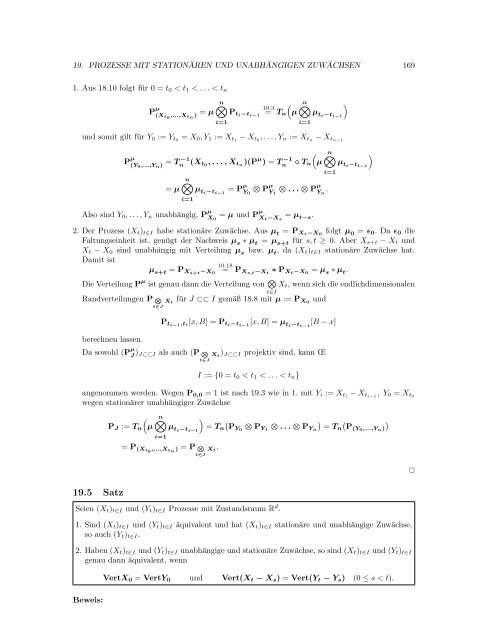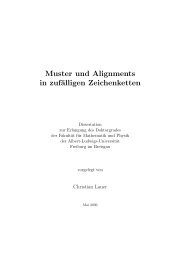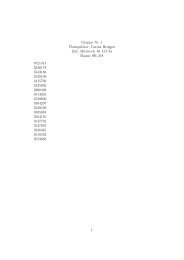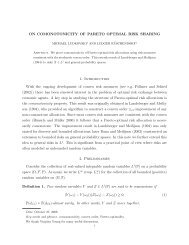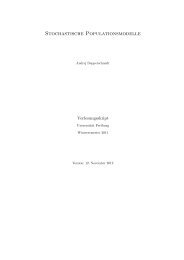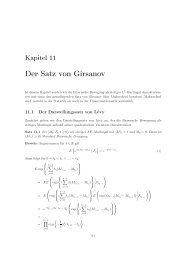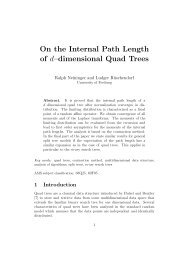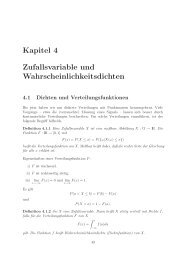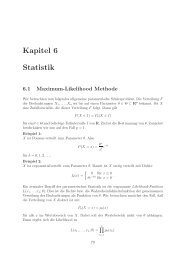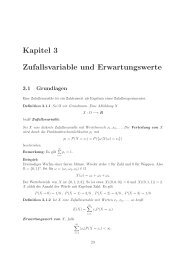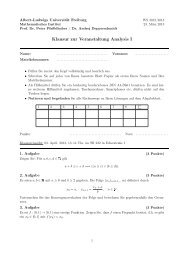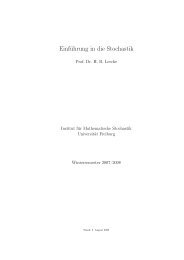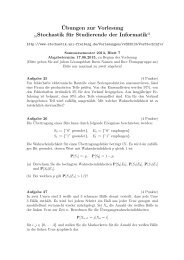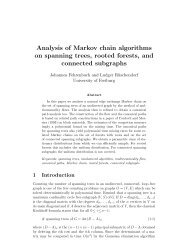Skriptum zur Wahrscheinlichkeitstheorie
Skriptum zur Wahrscheinlichkeitstheorie
Skriptum zur Wahrscheinlichkeitstheorie
Sie wollen auch ein ePaper? Erhöhen Sie die Reichweite Ihrer Titel.
YUMPU macht aus Druck-PDFs automatisch weboptimierte ePaper, die Google liebt.
19. PROZESSE MIT STATIONÄREN UND UNABHÄNGIGEN ZUWÄCHSEN 169<br />
1. Aus 18.10 folgt für 0 = t 0 < t 1 < . . . < t n<br />
P µ (X t0 ,...,X tn ) = µ n ⊗<br />
i=1<br />
P ti−t i−1<br />
19.3<br />
= T n<br />
(µ<br />
n⊗ )<br />
µ ti−t i−1<br />
und somit gilt für Y 0 := Y t0 = X 0 , Y 1 := X t1 − X t0 , . . . , Y n := X tn − X tn−1<br />
i=1<br />
(<br />
P µ (Y = T −1<br />
0,...,Y n) n<br />
(X t 0<br />
, . . . , X tn )(P µ ) = T −1<br />
n<br />
◦ T n µ<br />
= µ<br />
n⊗<br />
µ ti−t i−1<br />
= P µ Y 0<br />
⊗ P µ Y 1<br />
⊗ . . . ⊗ P µ Y n<br />
.<br />
i=1<br />
Also sind Y 0 , . . . , Y n unabhängig, P µ X 0<br />
= µ und P µ X t−X s<br />
= µ t−s .<br />
n⊗ )<br />
µ ti−t i−1<br />
2. Der Prozess (X t ) t∈I habe stationäre Zuwächse. Aus µ t = P Xt−X 0<br />
folgt µ 0 = ɛ 0 . Da ɛ 0 die<br />
Faltungseinheit ist, genügt der Nachweis µ s ∗ µ t = µ s+t für s, t ≥ 0. Aber X s+t − X t und<br />
X t − X 0 sind unabhängig mit Verteilung µ s bzw. µ t , da (X t ) t∈I stationäre Zuwächse hat.<br />
Damit ist<br />
10.18<br />
µ s+t = P Xs+t −X 0<br />
= P Xs,t−X t<br />
∗ P Xt−X 0<br />
= µ s ∗ µ t .<br />
Die Verteilung P µ ist genau dann die Verteilung von ⊗ t∈I<br />
X t , wenn sich die endlichdimensionalen<br />
Randverteilungen P N X t<br />
für J ⊂⊂ I gemäß 18.8 mit µ := P X0 und<br />
berechnen lassen.<br />
t∈J<br />
i=1<br />
P ti−1 ,t i<br />
[x, B] = P ti−t i−1<br />
[x, B] = µ ti−t i−1<br />
[B − x]<br />
Da sowohl (P µ J ) J⊂⊂I als auch (P N X t<br />
) J⊂⊂I projektiv sind, kann Œ<br />
t∈J<br />
I := {0 = t 0 < t 1 < . . . < t n }<br />
angenommen werden. Wegen P 0,0 = 1 ist nach 19.3 wie in 1. mit Y i := X ti − X ti−1 , Y 0 = X t0<br />
wegen stationärer unabhängiger Zuwächse<br />
19.5 Satz<br />
P J := T n<br />
(µ<br />
n⊗<br />
i=1<br />
= P (Xt0 ,...,X tn ) = P N<br />
) ( ) ( )<br />
µ ti−t i−1<br />
= T n PY0 ⊗ P Y1 ⊗ . . . ⊗ P Yn = Tn P(Y0,...,Y n)<br />
X t<br />
.<br />
t∈J<br />
Seien (X t ) t∈I und (Y t ) t∈I Prozesse mit Zustandsraum R d .<br />
1. Sind (X t ) t∈I und (Y t ) t∈I äquivalent und hat (X t ) t∈I stationäre und unabhängige Zuwächse,<br />
so auch (Y t ) t∈I .<br />
2. Haben (X t ) t∈I und (Y t ) t∈I unabhängige und stationäre Zuwächse, so sind (X t ) t∈I und (Y t ) t∈I<br />
genau dann äquivalent, wenn<br />
VertX 0 = VertY 0 und Vert(X t − X s ) = Vert(Y t − Y s ) (0 ≤ s < t).<br />
✷<br />
Beweis:


